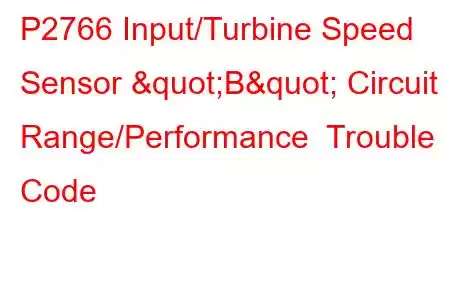Home » P2700-P2799 Codes » P2766 P2766 Input/Turbine Speed Sensor B Circuit Range/Performance
OBD-II Trouble Code Technical Description
Input/Turbine Speed Sensor "B" Circuit Range/Performance
What does that mean?
This diagnostic trouble code (DTC) is a generic powertrain code, which means that it applies to all 1996-newer vehicles (Ford, Honda, Mazda, Mercedes, VW, etc.). Although generic, the specific repair steps may vary depending on make/model.
When a diagnostic trouble code P2766 is exhibited, it is due to the powertrain control module (PCM) detecting a malfunction in the circuit for the designated input (or turbine) speed sensor known as "B". Although input and turbine speed sensors are virtually identical in design, some manufacturers choose to vary component terminology. The A designation is typically reserved for OBD-II equipped vehicles that use multiple input or turbine speed sensors.
The input/turbine speed sensor is usually an electromagnetic, 3-wire sensor used to monitor transmission input speed (recognized by the PCM as revolutions per minute or RPMs). The sensor is positioned near the rear of the torque converter (at the transmission input shaft) and is either mounted with a bolt/stud or threaded directly into the transmission case.
On the transmission main (or input) shaft, specially designed grooves (or a notched reluctor wheel) are present. The input shaft (or reluctor wheel) passes in close proximity to the end of the sensor; completing the electromagnetic circuit. As the grooves (or notches) pass by the sensor, the circuit is interrupted and an electronic pattern is formed. This pattern formation is received by the PCM as a waveform pattern that it further interprets as transmission input/turbine speed.
Transmission input/turbine speed is compared with engine RPM speed, percentage of engine load, and transmission output speed to determine the desired input speed RPM. If the actual input/turbine speed fails to coincide with the desired input/turbine speed, a code will be stored and a malfunction lamp may be illuminated.
Symptoms & Severity
In some instances, the PCM will place the transmission in 'limp-in' mode when this code is stored. The transmission will shift harshly in this mode. If the transmission begins to shift irregularly when you are presented with a P2766, the problem should be addressed immediately.
Symptoms of a P2766 code may include:
Speedometer and/or odometer fluctuation Harsh or erratic transmission shifting Failure of the transmission to shift at all Poor fuel efficiency Intermittent speedometer (odometer) operation The engine may stall when stopping the vehicleCauses
Potential causes for this code to set are:
Damaged, loose, or burned wiring and/or connectors A faulty input speed sensor B A defective output speed sensor B Malfunctioning transmission torque converter PCM failure or a PCM programming errorDiagnostic and Repair Procedures
A good starting point is always to check for technical service bulletins (TSB) for your particular vehicle. Your issue may be a known issue with a known fix put out by the manufacturer and can save you time and money during diagnosis.
An advanced diagnostic scanner, a digital volt/ohmmeter (DVOM), a manufacturer’s service manual, and possibly an oscilloscope will be helpful in diagnosing the P2766 code.
I would likely begin my diagnosis with a visual inspection of system wiring and connectors. Disconnected, corroded, burnt, or shorted wiring and/or connectors must be repaired or replaced. Don’t forget to test the battery and inspect battery cables and cable ends. Test alternator output as well.
I make it a habit to connect the scanner to the diagnostic port and retrieve all stored codes and write them down for future reference. I a
Read: 20


